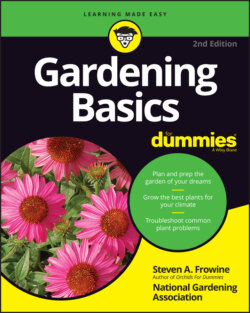Читать книгу Gardening Basics For Dummies - The Editors of the National Gardening Association, Steven A. Frowine - Страница 20
Caring for and feeding annuals
ОглавлениеLuckily, taking proper care of annuals is not rocket science. For the most part, annuals are easygoing, because they’re bred to be quite tough and durable. Many can withstand some neglect and still be productive — not that I recommend ignoring them!
Without a doubt, water is an annual’s number one need. All that lusty growth and continuous flowering requires fuel. A thirsty plant can’t sustain the show for long. Regular, deep soakings are best because they reliably supply water to the roots, which leads to a stress-free life of consistent growth and bud and bloom production. (Note that a drying-out plant favors its roots and, to a lesser extent, its leaves, in a bid for survival, automatically jettisoning its water-hogging buds and petals.) Note that annuals grown in pots, hanging baskets, or window boxes dry out much faster than ones grown in the ground. See Chapter 4 for more info on watering.
You can’t deny that regular doses of plant food or fertilizer significantly boost your annuals (make sure you apply it according to directions). For best flowering fertilize every six weeks with a granular or organic fertilizer or add a water-soluble fertilizer to your sprinkling can every week or so. The leaves become healthier and greener, and you end up with more buds and flowers. Chapter 4 contains information on fertilizer as well.
The rather unromantic term of deadheading simply refers to the practice of pinching or cutting off spent flowers. Your annuals look nicer when you do this, of course, but removing the flowers also serves another purpose: It thwarts the plant from the energy-intensive process of producing seeds, and the plant responds by diverting its energy back into making more flowers.
